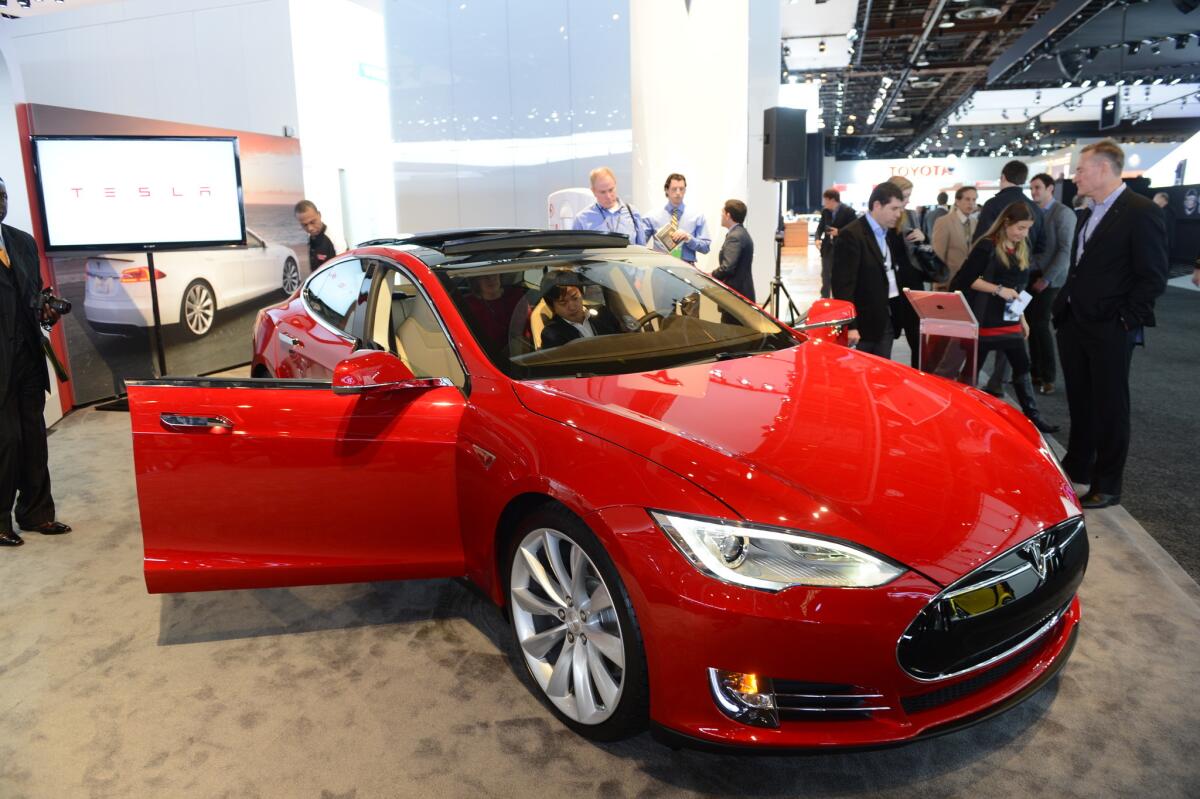Tesla posts revenue of $306 million, larger-than-expected loss

- Share via
Tesla Motors Inc. reported a larger-than-expected loss in the fourth quarter, but its revenue of $306 million beat expectations.
For the three months that ended Dec. 31, the electric car maker said it lost $90 million, or 79 cents a share. Excluding one-time charges, the company posted a loss of $75 million, or 65 cents; analysts had expected a loss of 53 cents a share.
The results released Wednesday were considered decent but not stellar for the Palo Alto, Calif., company, and shares fell 99 cents, or 2.6%, to $37.55 in after-hours trading. During regular trading, before the earnings were released, Tesla shares declined 74 cents, or 1.9%, to $38.54.
Tesla said it delivered about 2,400 Model S vehicles during the fourth quarter and sold most of its remaining Roadsters. It ended the year with more than $221 million in cash.
This year, Tesla plans to deliver about 20,000 Model S units, with about 4,500 deliveries expected in the current quarter. The company projected that it would “generate slightly positive net income” on a non-GAAP basis.
In a letter to shareholders, Chairman Elon Musk and Chief Financial Officer Deepak Ahuja said that the company planned to ramp up its introduction of Model S to customers worldwide.
“Many of our reservation holders and potential customers have yet to experience Model S. That will change this year,” they said. “We are on a journey to expand the presence of Model S and turn profitable.”
Wednesday’s release was the first detailed look at Tesla’s finances since September. At that time, production delays had forced the company to downgrade its projected 2012 revenue to $400 million to $440 million. Previous estimates were $560 million to $600 million.
Tesla had built just 255 Model S cars at that point, though it hoped to build 10 times as many by the end of 2012. The company said it has more than 13,000 fully refundable deposits on hand at the moment.
Delivering those Model S cars on time will be key to the survival of future Tesla products, which have been hampered by delays. The company initially planned to start building the Model X crossover SUV by the end of 2013, but now says production will start in 2014. The X will share its platform and many of its components with the Model S.
Down the line, and in keeping with a plan Musk laid out for Tesla in 2006, Tesla hopes to build a more affordable car, which it will need to sell in quantities greater than the S and X in order to ensure long-term viability.
Regardless of when and how Tesla builds its growing range of electric vehicles, the company faces long odds in making a dent in the sales of gas and diesel vehicles. Electric vehicles accounted for just 0.1% of U.S. sales in 2012, and that number is expected to rise to only 2% by 2020.
Many consumers remain wary of a vehicle with a perceived finite range. The cost of the batteries and related technologies in EVs also make it difficult to price them competitively with similar gas-powered vehicles.
Tesla found itself dealing with the issue of range in a very public fashion recently.
In an New York Times article titled “Stalled out on Tesla’s Electric Highway,” reporter John Broder detailed a recent trip from suburban Washington to Connecticut in a Model S. The goal was to test the feasibility of a road trip by using Tesla’s new Supercharging stations in Delaware and Connecticut.
Yet Broder ran into difficulties with the car’s range, which were exacerbated by cold weather. After he left the car overnight without plugging it in, the Model S ended the trip on the back of a flatbed truck.
The New York Times published the story on a Sunday. After Tesla’s stock dipped the next day, Musk went on the offensive. Through Twitter and several television appearances, he railed against the piece, calling it “fake” and telling CNBC: “We think the article is something of a setup, and it’s pretty unreasonable.”
Musk released the data logs from Broder’s car several days later, saying they backed up his claims.
The New York Times initially responded by saying the article was “completely factual,” and Broder wrote a follow-up piece defending his initial assertions. The Times’ public editor, Margaret Sullivan, eventually waded into the controversy with a blog post that offered measured criticism of Broder but defended his motives.
ALSO:
NYT’s public editor finds flaws in Tesla article
Review: Tesla’s Model S is truly a competitive sedan
Rise in gas prices good for small cars, but not hybrids and EVs







